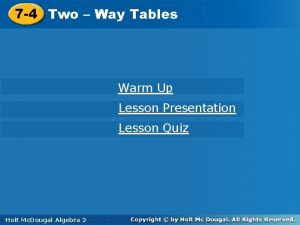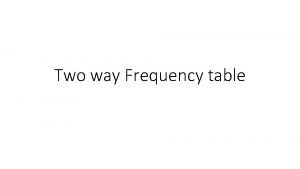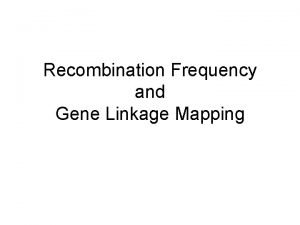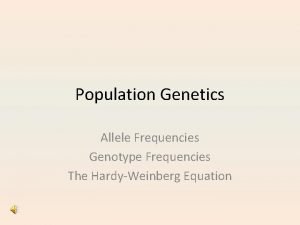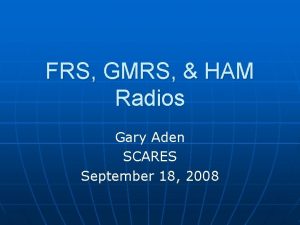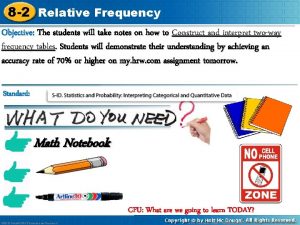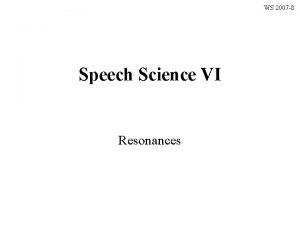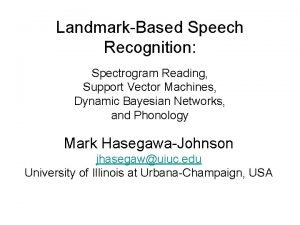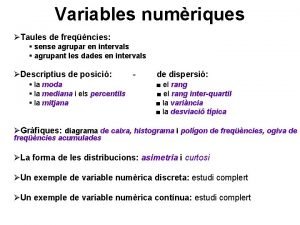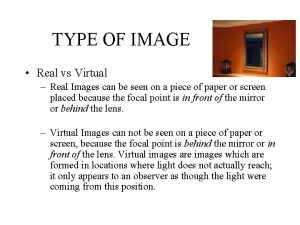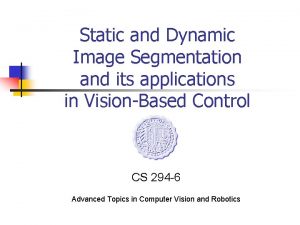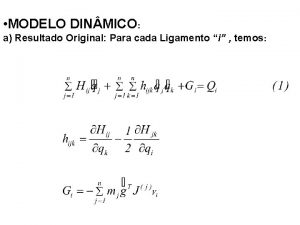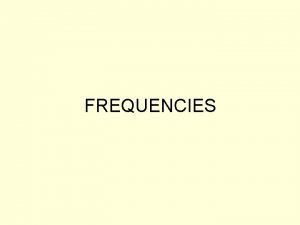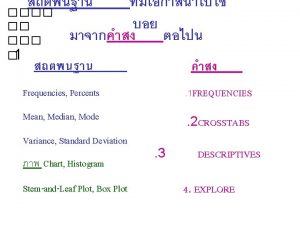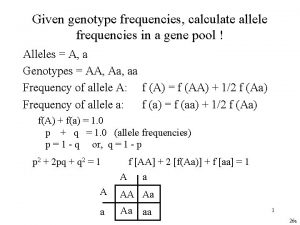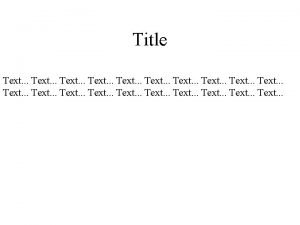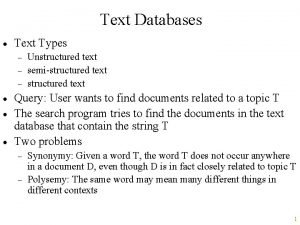Scanning Scanning image for text Scanning frequencies for






























![Monolithic Solution public class Upper. Case. Printer { public static void main (String args[]) Monolithic Solution public class Upper. Case. Printer { public static void main (String args[])](https://slidetodoc.com/presentation_image_h/163f2efb05851c0a4564348e522b115f/image-31.jpg)











































![Monolithic Solution public class Upper. Case. Printer { public static void main (String args[]) Monolithic Solution public class Upper. Case. Printer { public static void main (String args[])](https://slidetodoc.com/presentation_image_h/163f2efb05851c0a4564348e522b115f/image-75.jpg)












- Slides: 87

Scanning • • Scanning image for text. Scanning frequencies for radio stations. Finding words in a sentence Finding identifiers, operators, in a program char String Variable-size type – Indexing – Enumeration

Primitive Types • int, double, boolean, long, short, float, byte • char

Primitive Types • Constants (Literals & Named Constants) • Operations with Invocation Syntax

char Constants 16 bits char {letters, digits, operators. . . } ‘a’ ‘ 1’ ‘‘ ‘’’ ‘n’ ‘’ ‘A‘ ‘< ‘ ‘’ ‘’’ ‘ ‘\’ newline Escape sequence

Useful Escape Sequences

Ordering Characters ‘’ …. ‘a’ ordinal number (integer code) position in ordered character list ….


Converting between Characters and their Ordinal Numbers (int) ‘a’ ordinal number of ’a’ (char) 55 character whose ordinal number is 55 Implicit cast to wider type (int) ‘c’ - (int) ‘a’ 2 (char) 0 ‘’ ‘c’ - ‘a’ 2 (int) ‘d’ ? ? ? (char) (‘c’ - 2) ‘a’ (char) 1 ? ? ? (char) (‘A’ + 2) ‘C’ (char) (‘C’ - ‘A’ + ‘a’) ‘c’ (int) ‘’ (char) -1 0

A Useful Character Operation Character. is. Letter(c) true if c is a letter Character. is. Letter(‘a’) true Character. is. Letter(‘A’) true Character. is. Letter(‘ 1’) false Character. is. Letter(‘ ’) false

String constants variable size Object Type String {sequences of characters} “hello” “hello 123” ‘a’ “ 123” “a” “” “hellonn 123” “\”

Accessing String Components index String s = “hello world”; s. get. First. Char() s. get. Second. Char(). . . s. char. At(0) s. char. At(1) ‘h’ ‘e’ s. char. At(-1) s. char. At(11) s. length() String. Index. Bounds “ ”. length() exceptiom “”. length() 11 1 0

Accessing Sub. String public String substring (int begin. Index, int end. Index) s. substring(begin. Index, end. Index) s. char. At(begin. Index). . s. char. At(end. Index-1) “hello world”. substring(4, 7) “o w” “hello world”. substring(4, 4) “” “hello world”. substring(7, 4) String. Index. Bounds exceptiom

Changing Strings? Strings are read-only (immutable) “hello” + “world” “hello world” three different instances

Useful String Operations s. to. Lower. Case() copy of s with letters converted to lower case s. to. Upper. Case() copy of s with letters converted to upper case “Hello World”. to. Lower. Case() “hello world” “Hello World”. to. Upper. Case() “HELLO WORLD”

String Processing int i = 0; while (i < s. length()) { System. out. println (s. char. At(i)); i++; } prints each character on separate line

Dissecting a Loop loop condition int i = 0; while (i < s. length()) { System. out. println (s. char. At(i)); i++; } loop body

Finer-grained Dissection initalizing loop variables loop condition int i = 0; while (i < s. length()) { System. out. println (s. char. At(i)); i++; } real body Resetting loop variable for (int i=0; i<s. length(); i++) System. out. println(s. char. At(i));

Meaning of For Loop for (S 1; E; S 2) S 3 for (; E; ) S 3 for (; ; ) S 3 S 1; while ( E) { S 3; S 2; } while ( E) { S 3; } while ( true) S 3;

Scanning Problem

Scanning Input stream token Line 1 J token o h n Token Stream token Multi-line input stream Line 2 F token . K token e n n e d y

Solution • Monolithic Solution • Class Decomposition

Algorithm String input. Line

Algorithm String input. Line J marker o h 0 n F . K e Output: J n n e d y

Algorithm String input. Line J marker o h 1 n F . K e Output: J n n e d y

Algorithm String input. Line J marker o h 2 n F . K e Output: J n n e d y

Algorithm String input. Line J marker o h 5 n F . K e n Output: JF n e d y

Algorithm String input. Line J marker o h 6 n F . K e n Output: JF n e d y

Algorithm String input. Line J marker o h 8 n F . K e n Output: JFK n e d y

Algorithm String input. Line J marker o h 9 n F . K e n Output: JFK n e d y

Algorithm String input. Line J o h marker 14 n F . K e n Output: JFK n e d y
![Monolithic Solution public class Upper Case Printer public static void main String args Monolithic Solution public class Upper. Case. Printer { public static void main (String args[])](https://slidetodoc.com/presentation_image_h/163f2efb05851c0a4564348e522b115f/image-31.jpg)
Monolithic Solution public class Upper. Case. Printer { public static void main (String args[]) { String input = get. Input(); int index = 0; System. out. println("Upper Case Letters : "); while (index < input. length()) { char next. Char = input. char. At(index); if (Character. is. Upper. Case(next. Char)) System. out. print(next. Char); // token processing index++; } } public static String get. Input() { System. out. println("Please enter a string"); return Keyboard. read. Line(); } }

Storing instead of printing tokens String input. Line J o h marker 14 n F . K e n n String s = “JFK”; e d y

No reuse in Monolithic Solutions String s = ""; // token processing int index = 0; while (index < input. length()) { char next. Char = input. char. At(index); if (Character. is. Upper. Case(next. Char)) s += next. Char; // token processing index++; } int index = 0; System. out. println("Upper Case Letters : "); //token processing while (index < input. length()) { char next. Char = input. char. At(index); if (Character. is. Upper. Case(next. Char)) System. out. print(next. Char); // token processing index++; }

Class Decomposition? Main Class

Division of Labor in Radio Scanning

Division of Labor in Radio Scanning

Division of Labor in Radio Scanning

Division of Labor in Radio Scanning

Division of Labor in Radio Scanning

Division of Labor in Radio Scanning

Division of Labor in Radio Scanning

Division of Labor in Radio Scanning ?

Division of Labor in Radio Scanning

Class Decomposition Scanner Class instantiate Scanner Object calls Scanner User Main Class (Input & Output)

Class Decomposition instantiate Data. Input. Stream Instance read. Line() Scanner User Main Class (Input & Output)

Scanner User-Scanner Object Interaction Data. Input. Stream data. In = new Data. Input. Stream (System. in); int product = 1; while (true) { int num = Integer. parse. Int (data. In. read. Line()); if (num < 0) break; product = product*num; } System. out. println (product);

Data. Input. Stream Operations Line 1 Line 2 data. In. read. Line() Line 1 data. In. read. Line() Line 2 data. In. read. Line() IOException Multi-line input stream Line stream

Scanner Interface? Input stream token 1 token 2 scanner. next. Element() token 1 scanner. next. Element() token 2 scanner. next. Element() Scanner. Exception Token Stream

Scanner Interface? Input stream token 1 token 2 scanner. next. Element() token 1 scanner. next. Element() token 2 scanner. has. More. Elements() scanner. next. Element() false ? ? ? Token Stream

Uppercase Scanner Interface? J o token 1 h n F . token 2 K token 3 scanner. next. Element() ‘J’ scanner. next. Element() ‘F’ scanner. next. Element() ‘K’ scanner. has. More. Elements() scanner. next. Element() e false ? ? ? n n e d y

Enumeration Interfaces public interface Char. Enumeration { public char next. Element(); public boolean has. More. Elements(); } public interface String. Enumeration { public String next. Element(); public boolean has. More. Elements(); } public interface <Type>Enumeration { public <Type> next. Element(); public boolean has. More. Elements(); }

Using an Enumeration Interface J o token 1 h n F . token 2 K e n n e d y token 3 public static void print. Chars (Char. Enumeration char. Enumeration) { while (char. Enumeration. has. More. Elements()) System. out. print(char. Enumeration. next. Element()); }

Using an Enumeration Interface public class Upper. Case. Printer { public static void main (String args[]) { String input = get. Input(); print. Upper. Case(input); } public static String get. Input() { System. out. println("Please enter a string"); return Keyboard. read. Line(); } public static void print. Upper. Case(String s) { System. out. println("Upper Case Letters: "); print. Chars (new An. Upper. Case. Enumeration(s)); } public static void print. Chars (Char. Enumeration char. Enumeration) { while (char. Enumeration. has. More. Elements()) System. out. print(char. Enumeration. next. Element()); } }

Implementing Scanner public class An. Upper. Case. Enumeration implements Char. Enumeration { … public An. Upper. Case. Enumeration(String the. String) {. . . } public boolean has. More. Elements() {. . . } public char next. Element() {. . . ; } … }

Data Structure: Scanned String public class An. Upper. Case. Enumeration implements Char. Enumeration { String string; … public An. Upper. Case. Enumeration(String the. String) { string = the. String; . . . } public boolean has. More. Elements() {. . . } public char next. Element() {. . . ; } … }

Data Structure: marker string J o h n F . scanned part next. Element. Pos K e n Unscanned part n e d y

has. More. Elements() string J o h n F . next. Element. Pos public boolean has. More. Elements() {. . . } true K e n n e d y

has. More. Elements() string J o h n F . K e n n e d y next. Element. Pos public boolean has. More. Elements() {. . . } true

has. More. Elements() string J o h n F . K e n n e d y next. Element. Pos public boolean has. More. Elements() {. . . } false

has. More. Elements() string J o h n F . K e n n e d y next. Element. Pos //return true if next. Element. Pos is beyond end of string; false otherwise public boolean has. More. Elements() {. . . }

has. More. Elements() (edited) string J o h n F . K e n n e d y next. Element. Pos //return false if next. Element. Pos is beyond end of string; true otherwise public boolean has. More. Elements() { return string. length() > next. Element. Pos; }

has. More. Elements() string J o h n F . K e n n e d y next. Element. Pos //return false if next. Element. Pos is beyond end of string; true otherwise public boolean has. More. Elements() { return next. Element. Pos < string. length(); }

next. Element() string J o h n F next. Element. Pos public char next. Element() { } . K e n n e d y

next. Element() string J o h n F . K e n n e d next. Element. Pos //Assume next. Elem. Pos is at start of next token or end of string when //method is called. //Method makes sure this is also true before returning. //returns next element if one exists public char next. Elements() { } y

next. Element() string J o h n F . K e n n e d Unexecuted Loop next. Element. Pos //Assume next. Elem. Pos is at start of next token or end of string when //method is called. //Method makes sure this is also true before returning. //returns next element if one exists public char next. Elements() { char ret. Val = string. char. At(next. Elem. Pos) while (!Character. is. Upper. Case(string. char. At(next. Element. Pos))) } next. Elem. Pos++; return ret. Val; y

next. Element() string J o h n F . K e n n e d next. Element. Pos //Assume next. Elem. Pos is at start of next token or end of string when //method is called. //Method makes sure this is also true before returning. //returns next element if one exists public char next. Elements() { char ret. Val = extract. Token(); move. Past. Current. Token(); skip. Non. Token. Characters(); return ret. Val; } y

next. Element() string J o h n F . K e n n e d next. Element. Pos //Assume next. Elem. Pos is at start of next token or end of string when //method is called. //returns next token if one exists public char extract. Token() { return string. char. At(next. Element. Pos); } y

move. Past. Current. Token() string J o h n F . K e n n e d next. Element. Pos //Assume next. Elem. Pos is at start of next token or end of string when //method is called. //Moves past current token. public void move. Past. Current. Token() { next. Elem. Pos++; } y

skip. Non. Token. Characters() string J o h n F . K e n n e d y next. Element. Pos String. Index. Out. Of. Bounds // keep advancing next. Element. Pos until we hit the next upper case public void skip. Non. Token. Characters() { while (!Character. is. Upper. Case(string. char. At(next. Element. Pos))) next. Elem. Pos++; }

skip. Non. Token. Characters() string J o h n F . K e n n e d y next. Element. Pos short-circuit String. Index. Out. Of. Bounds? // keep advancing next. Element. Pos until we hit the next upper case or go // beyond the end of the string. public void skip. Non. Token. Characters() { while (next. Element. Pos < string. length() && !Character. is. Upper. Case(string. char. At(next. Element Pos))) next. Elem. Pos++; }

Initialization string j o h n F . K e n next. Element. Pos String string; int next. Element. Pos = 0; public An. Upper. Case. Enumeration(String the. String) { string = the. String; skip. Non. Token. Characters(); } n e d y

Complete Scanner public class An. Upper. Case. Enumeration implements Char. Enumeration { String string; int next. Element. Pos = 0; public An. Upper. Case. Enumeration(String the. String) { string = the. String; skip. Non. Token. Characters(); } public boolean has. More. Elements() { return next. Element. Pos < string. length(); } public char next. Element() { char ret. Val = extract. Token(); move. Past. Current. Token(); skip. Non. Token. Characters(); return ret. Val; } void move. Past. Current. Token() {next. Element. Pos++; } void skip. Non. Token. Characters() { while (next. Element. Pos < string. length() && !Character. is. Upper. Case(string. char. At(next. Element. Pos++; } char extract. Token() { return string. char. At(next. Element. Pos); } }

Scanner Pattern public class <Scanner Name> implements <T>Enumeration { String string; int next. Element. Start = 0; int next. Element. End = ? ? ? ; public An. Upper. Case. Enumeration(String the. String) { string = the. String; skip. Non. Token. Characters(); } public boolean has. More. Elements() { return next. Element. Start < string. length(); } public <T> next. Element() { <T> ret. Val = extract. Token(token. Length); move. Past. Current. Token(token. Length); skip. Non. Token. Characters(); return ret. Val; } void move. Past. Current. Token() {…}; void skip. Non. Token. Characters() {…}; char extract. Token() { …} }

Scanner User Again public class Upper. Case. Printer { public static void main (String args[]) { String input = get. Input(); print. Upper. Case(input); } public static String get. Input() { System. out. println("Please enter a string"); return Keyboard. read. Line(); } public static void print. Upper. Case(String s) { System. out. println("Upper Case Letters: "); print. Chars (new An. Upper. Case. Enumeration(s)); } public static void print. Chars (Char. Enumeration char. Enumeration) { while (char. Enumeration. has. More. Elements()) System. out. print(char. Enumeration. next. Element()); } }
![Monolithic Solution public class Upper Case Printer public static void main String args Monolithic Solution public class Upper. Case. Printer { public static void main (String args[])](https://slidetodoc.com/presentation_image_h/163f2efb05851c0a4564348e522b115f/image-75.jpg)
Monolithic Solution public class Upper. Case. Printer { public static void main (String args[]) { String input = get. Input(); int index = 0; System. out. println("Upper Case Letters : "); while (index < input. length()) { char next. Char = input. char. At(index); if (Character. is. Upper. Case(next. Char)) System. out. print(next. Char); // token processing index++; } } public static String get. Input() { System. out. println("Please enter a string"); return Keyboard. read. Line(); } }

Class Decomposition instantiate An. Upper. Case. Enumeration instance An. Uppercase. Printer

Class Decomposition instantiate An. Upper. Case. Enumeration instance An. Uppercase. Concatenator

Reuse of Enumeration String s = ""; while (char. Enumeration. has. More. Elements()) { s += char. Enumeration. next. Element(); } while (char. Enumeration. has. More. Elements()) System. out. print(char. Enumeration. next. Element());

Monolithic Solution String s = ""; // token processing int index = 0; while (index < input. length()) { char next. Char = input. char. At(index); if (Character. is. Upper. Case(next. Char)) s += next. Char; // token processing index++; } int index = 0; System. out. println("Upper Case Letters : "); //token processing while (index < input. length()) { char next. Char = input. char. At(index); if (Character. is. Upper. Case(next. Char)) System. out. print(next. Char); // token processing index++; }

Monolithic Solution to read. Line() initialize while there is more input set next line; user code to process next line …. move next line markers

Enumeration Vs Scanning J o token 1 h n F . token 2 K e n n token 3 public interface Char. Enumeration { public char next. Element(); public boolean has. More. Elements(); } e d y

Enumeration without Scanning All. Uppercase. Letters. In. Order ‘A’ ‘B’. . . ‘Z’ implements public interface Char. Enumeration { public char next. Element(); public boolean has. More. Elements(); }

Enumerating all Uppercase Letters //instance variables ? ? ? public char next. Element() { ? ? ? } public boolean has. More. Elements() { ? ? }

Enumerating all Uppercase Letters (edited) //instance variables ? ? ? public char next. Element() { ? ? ? } public boolean has. More. Elements() { ? ? }

Enumerating all Uppercase Letters public class All. Upper. Case. Letters. In. Order implements Char. Enumeration { char next. Letter = 'A'; public boolean has. More. Elements() { return next. Letter <= 'Z'; } public char next. Element() { char ret. Val = next. Letter; next. Letter = (char) (next. Letter + 1); return ret. Val; } }

Comparing Two Implementations J o token 1 h n F . token 2 K e n n e d token 3 An. Upper. Case. Enumeration implements public interface Char. Enumeration { public char next. Element(); public boolean has. More. Elements(); } ‘J’ ‘F’‘K’ y

Radically Different Behaviors Polymorphism print (new An. Uppercase. Enumeration(s)); print (new All. Uppercase. Letters. In. Order()); All. Uppercase. Letters. In. Order ‘A’ ‘B’. . . ‘Z’ implements public interface Char. Enumeration { Syntactic public char next. Element(); Specification! public boolean has. More. Elements(); }
 Text to text text to self text to world
Text to text text to self text to world I gullregnens månad
I gullregnens månad How to find conditional relative frequencies
How to find conditional relative frequencies Bymarcc
Bymarcc Relative frequency two way table
Relative frequency two way table What is conditional relative frequency
What is conditional relative frequency Two way relative frequency table definition
Two way relative frequency table definition Shares frequencies
Shares frequencies Recombination frequencies
Recombination frequencies What is gene frequency in genetics
What is gene frequency in genetics Marginal frequency
Marginal frequency Aden
Aden What is a joint relative frequency
What is a joint relative frequency A piano emits frequencies that range
A piano emits frequencies that range Call sign examples
Call sign examples Acars message format
Acars message format Formant frequencies
Formant frequencies Physics is phun
Physics is phun Hf beacon frequencies
Hf beacon frequencies Formant frequencies
Formant frequencies Moon bounce frequencies
Moon bounce frequencies Formant frequencies
Formant frequencies Civil air patrol frequencies
Civil air patrol frequencies Agrupar variables spss
Agrupar variables spss Spettro elettromagnetico
Spettro elettromagnetico Allele frequencies
Allele frequencies Real vs virtual image
Real vs virtual image Real image vs virtual image
Real image vs virtual image Translate
Translate What is image restoration in digital image processing
What is image restoration in digital image processing Compression models in digital image processing
Compression models in digital image processing Key stage in digital image processing
Key stage in digital image processing Analog image and digital image
Analog image and digital image Variable length coding in digital image processing
Variable length coding in digital image processing Image sharpening in digital image processing
Image sharpening in digital image processing Motion segmentation
Motion segmentation Geometric transformation in digital image processing
Geometric transformation in digital image processing Area of convergence
Area of convergence False contouring
False contouring Appuyez sur l’image qui est dans le bon sens
Appuyez sur l’image qui est dans le bon sens Physical image vs logical image
Physical image vs logical image Qual o resultado de: image image
Qual o resultado de: image image Contra harmonic mean filter
Contra harmonic mean filter Walsh transform in digital image processing
Walsh transform in digital image processing Imtransform matlab
Imtransform matlab Noise
Noise E
E Melody randford
Melody randford Fspos
Fspos Typiska drag för en novell
Typiska drag för en novell Tack för att ni lyssnade bild
Tack för att ni lyssnade bild Ekologiskt fotavtryck
Ekologiskt fotavtryck Shingelfrisyren
Shingelfrisyren En lathund för arbete med kontinuitetshantering
En lathund för arbete med kontinuitetshantering Särskild löneskatt för pensionskostnader
Särskild löneskatt för pensionskostnader Personlig tidbok för yrkesförare
Personlig tidbok för yrkesförare A gastrica
A gastrica Förklara densitet för barn
Förklara densitet för barn Datorkunskap för nybörjare
Datorkunskap för nybörjare Tack för att ni lyssnade bild
Tack för att ni lyssnade bild Mall för debattartikel
Mall för debattartikel Delegerande ledarskap
Delegerande ledarskap Nyckelkompetenser för livslångt lärande
Nyckelkompetenser för livslångt lärande Påbyggnader för flakfordon
Påbyggnader för flakfordon Kraft per area
Kraft per area Publik sektor
Publik sektor Presentera för publik crossboss
Presentera för publik crossboss Teckenspråk minoritetsspråk argument
Teckenspråk minoritetsspråk argument Vem räknas som jude
Vem räknas som jude Treserva lathund
Treserva lathund Mjälthilus
Mjälthilus Claes martinsson
Claes martinsson Cks
Cks Lågenergihus nyproduktion
Lågenergihus nyproduktion Mat för idrottare
Mat för idrottare Verktyg för automatisering av utbetalningar
Verktyg för automatisering av utbetalningar Rutin för avvikelsehantering
Rutin för avvikelsehantering Smärtskolan kunskap för livet
Smärtskolan kunskap för livet Ministerstyre för och nackdelar
Ministerstyre för och nackdelar Tack för att ni har lyssnat
Tack för att ni har lyssnat Mall för referat
Mall för referat Redogör för vad psykologi är
Redogör för vad psykologi är Matematisk modellering eksempel
Matematisk modellering eksempel Atmosfr
Atmosfr Borra hål för knoppar
Borra hål för knoppar Orubbliga rättigheter
Orubbliga rättigheter R formel
R formel Tack för att ni har lyssnat
Tack för att ni har lyssnat


